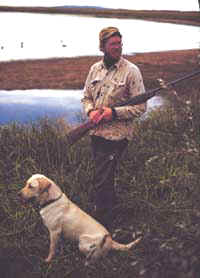Whether you are planning a guided or an unguided hunt (sometimes called "self-guided" or "do-it-yourself", or "DIY" hunts), you can find the information you need by starting with this page.
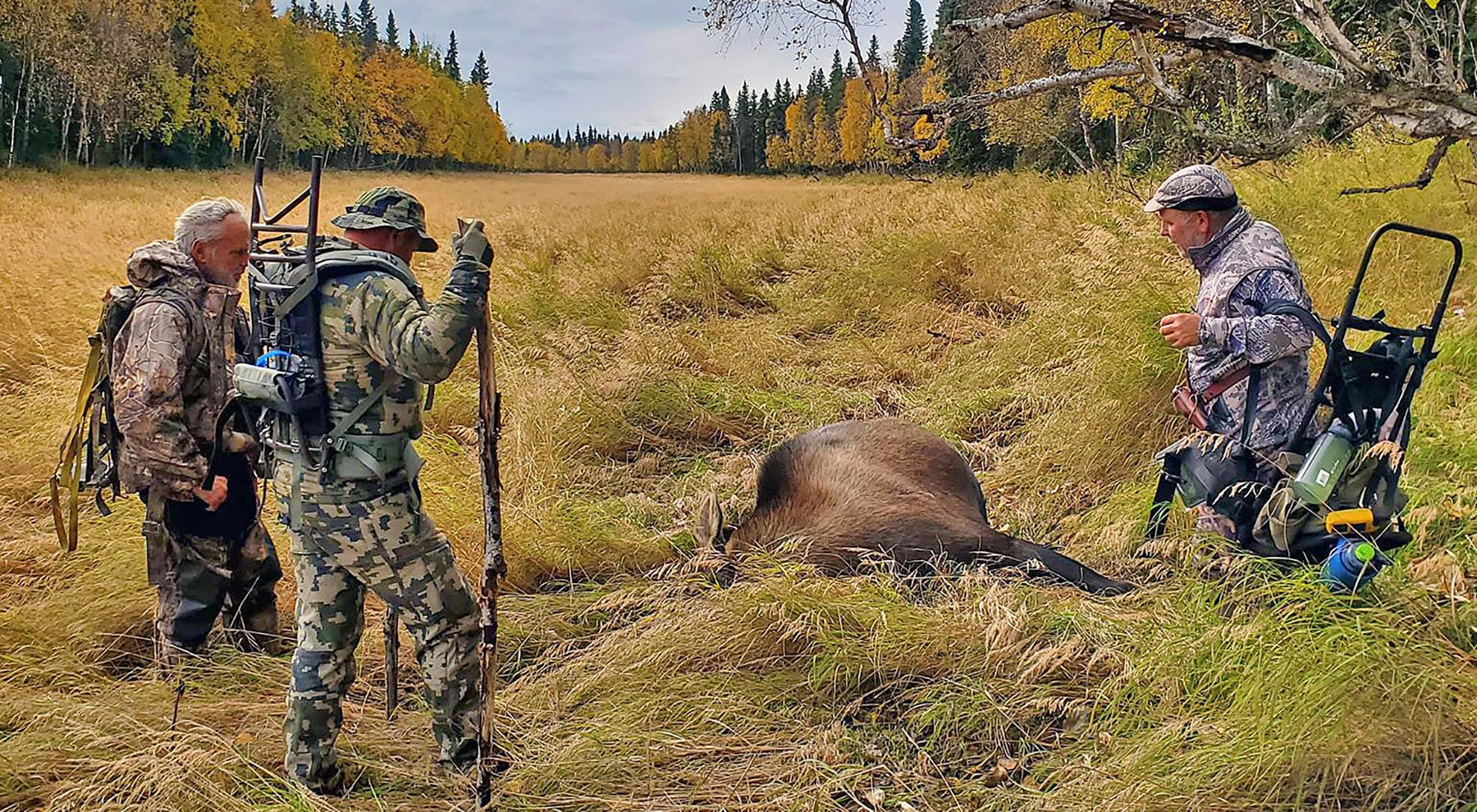
Getting Started: Species Selection
Most hunters start with an idea of what species they want to hunt. Though many areas in Alaska offer the opportunity to take multiple species on the same hunt, it's unlikely you will find a place that offers premium hunting for more than one species. Therefore on multi-species hunts it is important to plan your hunt around one primary species and let everything else come in after that. If you're just getting started with this, take some time to become familiar with the available species first. Here are the main species that are hunted in Alaska.
Alaska has more available big-game species than any other state in the country. Many of these species have overlapping ranges, so multi-species hunts are common. On the other hand, there are few areas that offer good opportunities for more than two species, so hunters should consider focusing their hunt on a primary animal and let everything else come after that.
Bison
Alaska is home to two species of bison; the plains bison and the larger wood bison. This is Alaska's largest big-game animal and is hunted on a drawing permit basis almost exclusively. The exception involves certain private herds on Kodiak Island, which are owned by farmers who occasionally allow animals to be harvested on a fee basis. Learn more about Alaska's bison hunting opportunities on our bison hunting page.
Black Bear
Black bears are distributed throughout the state of Alaska, except the Seward Peninsula, the Yukon-Kuskokwim delta, the Alaska Peninsula, the Kodiak-Afognak archipelago and north of the Arctic circle.
Black bears are hunted in both the spring and the fall. Spring hunts typically occur in April and May, and may even run into June in some areas. The days are long and can be quite pleasant. Spring bears are hunted differently in different regions of the state. In Region 1 (Southeast Alaska) they are commonly hunted by cruising shoreline areas by boat in search of bears patrolling the tide line for washed-up carrion, kelp, and other vegetation they like. Black bears are voracious when they first emerge from the den, and they'll go straight to the most abundant food sources they can find. In Region 2, Southcentral Alaska and the Kenai Peninsula, black bears are commonly hunted using spot-and-stalk methods. Hunters glass mountainsides for bears emerging from dens in the snow.m Blackies will den in flat bottomland, but locating dens in these places is next to impossible. Bears may exit a den and re-enter it several times before descending, and will, in the process, track mud from inside the den out into the snow. Look for round den openings in the snow with a dirty streak below them as evidence of emerging bears. Spring bears are also hunted in Region 2 over bait. There are specific regulations pertaining to bait stations, so hunters need to follow all the proper protocols. There is nothing quite like watching a wild black bear approaching a bait station. It's a great way to introduce younger hunters to bear hunting.
Black bears are also hunted in the fall months; typically any time from late August into the month of October. For more specific information on black bear hunting in Alaska, visit our Black Bear Hunting page. Check out the ADF&G website for more information on black bears.
Brown / Grizzly Bear
Most hunters draw a distinction between brown bears and grizzly bears. Brown bears are typically larger, and are recognized as bears that have ready access to salmon. Most interior bears or bears from the Arctic, are recognized at grizzlies. Bears are usually measured by their skull size, for records book considerations. But bears from some regional areas have proportionally larger skulls than similar-sized bears from another area. For this reason, when it comes to determining the sheer size of a bear, many hunters are less interested in skull size and more interested in the size of the wrapper the bear came in. A large brown bear squares over nine feet, and some bears measure over ten feet. Reports of bears approaching twelve feet occasionally float around the hunting community, but such stories are usually sketchy on details and may be nothing more than fodder for "tall tales" contests. Or perhaps not. A mature grizzly, on the other hand, will square out at between six and seven feet. The term "square" in reference to bear hides refers to the measurement of an unstretched hide, from the tip of the tail to the tip of the nose, added to the measurement from claw to claw across the front legs (usually the widest part of the hide), added together and divided by two. Thus, a bear hide that measures 8' 6" from nose to tail, and 8' from claw to claw, would square out at 8'3", a respectable bear in most areas of Alaska.
The Alaska Department of Fish and Game (ADF&G) makes no distinction between brown and grizzly bears when it comes to seasons, bag limits, and other regulatory issues. Common means of take include rifle, muzzleloader and archery. With the exception of some predator control situations, bait and dogs are not allowed. In most cases cubs cannot be harvested, and the taking of sows is discouraged. Evidence of the sex of the bear (penis sheath or vaginal orifice) must be left naturally attached to the hide until the bear is sealed. In many cases, the skull and hide of a sport-taken brown / grizzly bear must be taken to the nearest ADF&G office for sealing within 30 days of the conclusion of the hunt. Sealing consists of measurements of the hide and skull of the bear, determination of sex, and sometimes involves the extraction of a molar for biological study purposes.
Brown / grizzly bear meat is not usually salvaged by sport hunters, however bears taken under subsistence regulations are salvaged for human consumption. The meat can be quite good if the bear has been feeding on berries during the fall months.
See our Brown Bear Hunting page for more details on biology, distribution, hunting tactics and other resources pertaining to brown bear hunting.
Caribou
Caribou are fascinating animals to hunt. They are mostly a herd animal and may wander thousands of miles in a given year, moving from winter range to summer range. A flight over caribou country reveals a lacework of intersecting trails across the tundra that have been trod by thousands of caribou for hundreds of years. These migration corridors are the focal point of hunting efforts during the fall season.
Unlike most ungulates, both bulls and cows have antlers. The antlers on cow caribou are usually smaller than those of a mature bull, however in areas that allow only the taking of bulls, it is the hunter's responsibility to know how to tell a bull from a cow. Look for the penis sheath extending below the belly of the animal for positive proof that you're looking at a bull.
Refer to our Caribou Hunting page for more details, resources and information related to hunting caribou in the regions of Alaska where they are found. Of special interest is our Adak Caribou Hunting page.
Dall Sheep
Sheep are distributed throughout most mountainous regions of Alaska, with the exceptions of the southeast portion of the state, and the Alaska Peninsula's Aleutian Range. The primary Dall sheep hunting areas include the Wrangell Mountains, the Kenai Mountains, the Chugach Mountains, the Talkeetna Mountains, the Alaska Range and the Brooks Range. All of these areas can be hunted from the road system on a limited basis (due to access issues), but most who hunt these places get there by aircraft. Visit our Dall sheep hunting page for more information.
Deer
Alaska's only indigenous deer species is the diminutive Sitka blacktail deer, native to Southeast Alaska and many islands of Prince William Sound. They're also found in good numbers in the Kodiak / Agognak archipelago. Visit our deer hunting page for details and resources on hunting blacktail deer in Alaska.
Elk
Alaska is home to two species of transplanted elk; Roosevelt elk and Rocky Mountain elk. They are found in isolated pockets in Southeast Alaska, but exist in greater numbers on Afognak and Raspberry islands, in the Kodiak area. In all cases they are available for hunting exclusively on a drawing permit basis. Visit our elk hunting page for more information.
Goat
The Rocky Mountain goat is found in many parts of the Southeast panhandle, along with the Kenai Peninsula, Kodiak Island and some parts of Southcentral Alaska. They're a magnificent animal to hunt and the scenery in goat country is second to none. Check out our goat hunting section for details on the species and how to hunt them.
Moose
Four subspecies of moose inhabit North America; the Eastern moose of northern New England and into southeastern Canada, the Shiras moose of Colorado, Montana, Idaho, Washington and parts of southern British Columbia, the Canadian moose of central and western Canada, and the Alaska-Yukon moose of the western Yukon and the state of Alaska. The Alaska-Yukon moose is the largest moose found in North America, with live body weights in excess of 1500 lbs. and standing seven feet high at the shoulder. They're the second-largest land mammal in North America, behind the bison.
Moose are not difficult animals to hunt. Bulls are relatively easy to spot from glassing locations, and can be called by imitating various vocalizations or by simulating the sounds of antler scraping and brush-thrashing during the pre-rut period (September 10 through the beginning of October). The greatest challenges of moose hunting are finding them (densities can be as low as .25 moose per square mile or even lower), accessing them (many moose live in boggy areas where access is difficult or impossible), and in moving a moose once it has been harvested (in most cases the moose must be reduced to backpack-sized pieces and packed out of the woods to a raft or a base camp, from which it is flown out of the field. Despite all the challenges, most hunters anticipate the thrills of hunting them, and eagerly anticipate their days in moose camp.
For details on field tactics, including care of meat and tropies, visit our moose hunting page.
Muskoxen
Though Alaska's muskoxen herds are not nearly as large as they were many years ago, they still exist in huntable numbers throughout the Arctic and on some islands off the west coast of the state. They are managed on a drawing permit basis, with much competition for the few available tags. Visit our muskox hunting page for more details.
Wolf
Wolves may be encountered anywhere in the state, however they are in greatest abundance in Regions 2, 3, 4 and 5. An apex predator, they have potentially significant impact on local populations of moose, caribou, Dall sheep, goat and other game species.
Wolves are often heard howling in the distance, particularly in the morning and evening, but they are very difficult to hunt. They travel in packs of various sizes and are very intelligent. By the time you see a wolf, chances are it saw you first and has exited the area.
Hunters serious about taking a wolf in Alaska should be prepared for long shots at wolves that may appear suddenly and, just as suddenly, disappear.
Finding a Place to Hunt
Begin by looking at the regions of Alaska until you get a feel for what each area offers in terms of species, weather patterns, terrain and vegetation. If you're planning a DIY hunt, visit our Unguided Hunting page. Visit our Guided Hunts page for critical details and decision points related to finding and working with a guide for your dream hunt.
Are you looking for an exceptional deal on a guided Alaska big-game hunt? Visit our Discounted Hunts forum for current listings!
Places
Our Places pages give you an overview of how the state is laid out. Each area has its own unique species, weather, terrain, vegetation, and other factors that make it different from the others Gaining an understanding of the different areas of Alaska will help you decide what area you want to hunt.
Alaska Hunting Forums
Our Alaska Hunting Forums are an exceptional source of Alaska hunting information. The forums are quite busy, and boasts several guides who regularly post high quality information. Most folks start in our main Alaska Hunting Forum before specializing in some of our other hunting forums. Here is a partial list of our Alaska hunting-related forums:
- Alaska Float Hunting Forum
- Bear Stands and Baiting Forum
- Alaska Meat Care and Processing Forum
- Alaska Trophy Care and Taxidermy Forum
- Alaska Bowhunting Forum
- Alaska Muzzleloader Hunting Forum
- Alaska Small Game Hunting Forum
- Trapping and Predator Hunting Forum
- Waterfowl Hunting Forum
- Gundog Training Forum
- Alaska Game Management Forum
If you are looking for answers, we suggest you check out these resources. You can search all of the forum messages with either our in-house search system, or Google.
Dealing with the Logistics
Once you know what species you are hunting , and have an idea where to go, you need to nail down your air charter, raft rental, sat phone rental and camping gear, along with any special equipment purchases. Then you may need help moving all of your gear to the village and back, if you are flying out of a remote town. Connect with all of these equipment and service providers in our directory.
Our Directory
An extensive listing of hundreds of businesses that provide goods and services you need for your hunting trip. The directory includes Alaska hunting guides, Alaska air taxis, Alaska hunting lodges, transporters and much more.
Getting More Information
Our store features hundreds of books, maps and DVD titles specifically focused on hunting in Alaska, including field techniques, float hunting, species, hunting stories and much more.
Alaska Hunting News blog
If you want to keep up with Alaska hunting news , we invite you to subscribe to our blog, "Alaska Hunting News".
An Introduction to Alaska Hunting, by David Johnson
(this is an old article by the original founder of our site, David Johnson. David is a retired biologist from the Alaska Department of Fish and Game, and he produced similar material for the department. This article, though time-worn, still contains much valuable information. We have updated it and are including it here as a service to you. -webmaster)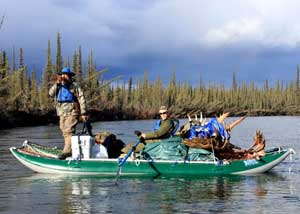
I am deeply grateful for my Alaska hunting experiences: moose in the foothills amid the colors, sounds and smells of fall; caribou on mountain ridgetops, deer in the coastal rainforest, waterfowl on the flats….and more. If you dream of hunting Alaska, don’t miss it. Even if your hunt is unsuccessful in terms of taking game, you will have some powerful memories of hunting Alaska’s wilderness.
But be sure your expectations of Alaska hunting are realistic. There is not game behind every bush in Alaska. Regulations and land ownership are complex in some areas. Highway vehicles are rarely a great way to get to hunting areas. Even the very act of hunting Alaska can be hazardous because of dangerous game, early winter weather, and distance from help.
But don’t let that stop you!
Here’s the good news: hunting can be spectacularly good in Alaska. Some caribou herds number in the hundreds of thousands and contain impressively large animals. Moose populations are dense in some areas. Moose racks larger than 70 inches are not unheard of. Coastal Alaska habitats produce large numbers of brown and black bears. Dall sheep or goats populate most mountain ranges. Yes, it can be very good.
Alaska hunting can best be examined by regions. 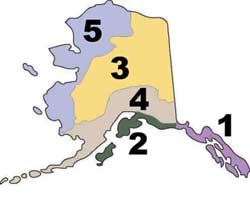 Hunting opportunities vary from deer hunting Southeast Alaska's coastal rainforest (Region 1), to muskox hunting on the windswept tundra of western Alaska (Region 5), to hunting for moose in the hills of the Interior (Region 3), to high mountain Dall sheep hunting in Southcentral (Region 4), to brown bear hunting world-famous Kodiak (Region 2)....and much more. If you are interested in hunting Alaska, your task is to find the combination of the species you want to hunt, the kind of country you want to hunt in, and how you want to hunt. The resources of the Alaska Outdoors Supersite are designed to help you do that. Let's look first at Alaska's regions and what they are like. Follow the links within the regional descriptions to find more specific information.
Hunting opportunities vary from deer hunting Southeast Alaska's coastal rainforest (Region 1), to muskox hunting on the windswept tundra of western Alaska (Region 5), to hunting for moose in the hills of the Interior (Region 3), to high mountain Dall sheep hunting in Southcentral (Region 4), to brown bear hunting world-famous Kodiak (Region 2)....and much more. If you are interested in hunting Alaska, your task is to find the combination of the species you want to hunt, the kind of country you want to hunt in, and how you want to hunt. The resources of the Alaska Outdoors Supersite are designed to help you do that. Let's look first at Alaska's regions and what they are like. Follow the links within the regional descriptions to find more specific information.
REGION 1: Southern Alaska Panhandle, Yakutat / Cordova Area
Southeast Alaska's geography and climate provide conditions for good habitat for a variety of big game. Sitka black-tailed deer are found throughout the region, but in best numbers on the "ABC islands" – Admiralty, Baranof and Chichagof. The ABC’s are also the home of the largest populations of brown bears in the region. Black bears are particularly abundant on Prince of Wales island and the islands in the central portion of the region. Goats are indigenous to the coastal mountains and have been transplanted to Baranof Island. A late 1980’s transplant brought elk to Southeast, and a limited hunting season opened in 1997. Moose are not numerous in Southeast Alaska as they are in other areas of the state, although reasonable populations are found on the Yakutat Forelands, in the Haines area, and smaller populations near Juneau, Petersburg and Ketchikan. Wolves are found throughout Southeast Alaska except on the ABC islands. Much of the guided big game hunting in this region is by boat. Boat rentals are available in some communities for hunters wanting to roll their own. A variety of air charter services with float planes also provide an important transportation alternative.
Our Southeast Alaska Hunting archive page. Check this link for our original page on hunting Southeast, just to get a feel for the area and what you can expect.
More Southeast Alaska regional hunting information: Geography, weather, transportation, species, seasons, & RealAudio (tm) interviews:
Sitka area: Best known for brown bear and deer hunting
Petersburg area: Black bear numbers are good here; also deer
Ketchikan area: Also good for black bear and deer hunting as well as mountain goat.
Juneau area: The region's best moose hunting is found in this area; also some deer and goats.
Cordova area: Known for trophy moose hunting, along with deer and brown bear.
Big-Game Species Available in Region 1:
Black Bear | Brown / Grizzly Bear | Deer | Elk | Goat | Moose | Wolf
For general Southeast Alaska hunting information and regulations information, contact the Alaska Department of Fish and Game, Division of Wildlife Conservation, PO Box 240020, Douglas, AK 99824-0020. Tel. (907) 465-4265, FAX: (907) 465-4272.
REGION 2: North Gulf Coast, Kenai Peninsula, and the Kodiak / Afognak archipelago
This area contains several big-game species, including Sitka blacktailed deer, moose, Dall sheep, caribou, goat, black bear and brown bear. Deer are currently abundant on Kodiak Island and are found in good numbers on the islands of Prince William Sound. These are transplanted deer originating from Southeast Alaska, and as is the case in Alaska, annual abundance depends much on winter snowpack. Kodiak and the Alaska Peninsula are famous for their brown bear populations. Farther inland, many Alaskans refer to these bears as grizzlies. There are some size and color distinctions but no clear line divides the populations. That said, hunters interested in bears that meet the official distinctions that the Boone and Crockett Club makes between brown and grizzly bears should consult that organization's current standards. They've drawn a somewhat arbitrary line across the state such that bears taken south and west of Denali Park are considered brown bears, and bears taken north of that line are recorded as grizzlies. The Alaska Department of Fish and Game makes no such distinction, considering both types as "brown/grizzly bears" for regulatory purposes.
Moose populations on the Kenai Peninsula, once achieving near legendary status around statehood, have slipped due to habitat degradation / forestation, and most moose hunting on the Kenai is now by drawing permit only. Some pockets of outstanding opportunity remain, however, most notably the Tustamena Lake area. The most practical way of hunting this area involves horseback hunting, as the distances to be traveled by foot are prohibitive. Some caribou hunting opportunities exist, with drawing permits available for the Kenai mountains area. Black bears are found in all areas of this region with the exception of the Kodiak / Afognak islands area, which are dominated by brown bears. Elk were transplanted to Afognak and Raspberry islands some years ago, and the population is healthy enough in both places to allow hunting by drawing permit. These are Roosevelt elk, and the antler configuration of bulls from this area are somewhat smaller than those found in indigenous populations in the Pacific Northwest, the heartland of this species. The biggest challenges elk hunters find in these areas are weather, steep and heavily vegetated terrain, and predatory brown bears who may appropriate a kill before it can be packed to the beach.
Available species in Region 2:
Bison | Black Bear | Brown / Grizzly Bear | Caribou | Dall Sheep | Deer | Elk | Goat | Moose | Wolf
REGION 3: Central Interior and Eastern Arctic
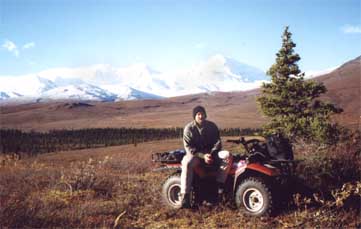
Moose and caribou are the most visible big game in the interior and eastern arctic. This region encompasses the huge area drained by the Yukon and Kuskokwim rivers and draining into the Bering Sea, east of Prudhoe Bay. This is relatively dry country, and habitats vary from the forested Interior to the western and arctic treeless tundra.
Regulations in some parts of the state require up to four brow tines on at least one side or 50" antler spread. The regulation allows more opportunity, but hunters must look very carefully before shooting.
Caribou exist in more or less discrete herds, and some of these herds are huge. Moose are found in good numbers throughout the region, with some population increases occurring in the Yukon-Kuskokwim delta.
Both black and grizzly bears inhabit the region, but bear populations here are not as dense as in the coastal regions. Populations of wild bison, transplanted earlier in the century from Montana, are established and may be hunted on a draw permit basis. Dall sheep are found in most of the mountain ranges.
Wolves are also numerous in places in this region. It is not uncommon to hear wolves howling on a fall evening while sitting around the hunting campfire. Wolverines are distributed across the region, but because they are usually solitary, sightings are rare.Four wheelers have made much more of Alaska accessible to moose hunters, although care must be taken to avoid long lasting damage to the land.
Waterfowl Opportunities
Waterfowl hunting is locally good, but again, only for a short time. Waterfowl begin moving out of the Interior as early as mid-August, several weeks before the beginning of the hunting season. It is not uncommon, for example, to see flocks of hundreds of sandhill cranes (a huntable species in Alaska) staging for flights south during the September moose season.
Some of the best Interior waterfowl hunting occurs on broad river flats, like the Minto Flats west of Fairbanks, shown here.
Upland Game Birds
There is a wide variety of game birds here, and populations can be quite good at the high point of their cycle of abundance. Grouse species include ruffed, spruce and sharptail. In the hills and mountains, hunters may find willow, rock and whitetail ptarmigan.
Ruffed grouse, like this Interior Alaska bird, and other game birds, including spruce, sharp-tailed, and blue grouse, as well as willow, rock and white-tail ptarmigan are cyclically abundant in Alaska.
Big-game species available in Region 3:
Bison | Black Bear | Brown / Grizzly Bear | Caribou | Dall Sheep | Moose | Wolf
For more Interior Alaska information contact the Alaska Department of Fish and Game, Division of Wildlife Conservation, 1300 College Rd, Fairbanks, AK 99701-1599. Tel (907) 459-7313 FAX (907) 452-6410.
REGION 4: SouthCentral, Alaska Peninsula
SouthCentral offers an incredible diversity of topography and land cover. This region begins at Icy Bay on the Gulf of Alaska coast, and generally is comprised of the lands draining into the Gulf and Bristol Bay, and includes the Alaska Peninsula and related islands. Climate ranges from wet along the coast to dry inland. The Alaska Peninsula is notorious for bad weather, including high winds.
Moose in parts of Southcentral were recent victims of excess predation by wolves, brown bears, and black bears, however a predator control effort was initiated in 2008 and moose numbers seem to be on the rise. Nonresident moose hunters must check the regulations to identify areas that are open to nonresident harvest of moose. The Matanuska and Susitna valleys have excellent moose habitat and have traditionally produced well. Caribou numbers in the Nelchina Basin (GMU 13) are on the rise, however the caribou population in the Western Alaska Range, normally low, has dipped in recent years due to predation. Regulations limit the harvest of the most easily accessible population to Alaska residents. Dall sheep are found in the drier mountains in the region, and mountain goats nearer the coast, although there is some overlap. Black bears are not as numerous as in Southeast, but they are widespread and numbers are good.
Wolf and wolverine are present. In fact, wolves tend to be numerous wherever there are good numbers of moose and caribou.
Waterfowl hunting can be quite good here, although the effective season is short as birds are moving south. The season generally opens the first of September, but most of the birds will still be in eclipse plumage, regaining their full colors by mid to late September. Upland bird hunters will be pleased to see growing ruffed grouse populations from recent transplants to the Matanuska and Susitna valleys and to the Kenai Peninsula. Ptarmigan are found above treeline throughout the region.
Species available in Region 4:
Bison | Black Bear | Brown / Grizzly Bear | Caribou | Dall Sheep | Goat | Moose | Wolf
King Salmon area hunting: An archive article outlining hunting opportunities in the area near King Salmon, Alaska.
For more general Southcentral Alaska hunting information and regulations contact the Alaska Department of Fish and Game, Division of Wildlife Conservation, 333 Raspberry Rd, Anchorage, AK 99518-1599. Tel (907) 267-2347 FAX (907) 267-2433.
REGION 5: Western Arctic, Yukon / Kuskokwim Delta
Muskox, extirpated from Alaska in the late 1800's. are now present in good numbers in some areas of coastal western and arctic Alaska. Black bear range includes the southern portions of this region, but ends in the foothills of the Brooks Range, which runs across the arctic from east to west. Brown / grizzly bears are found throughout the area. Caribou are found mostly in the arctic, with smaller numbers found south of GMU 23. Unit 18 has very few caribou. Dall sheep are also available, with some found in the Brooks Range. Moose are found throughout the area, however some places have smaller populations and are managed on a drawing permit basis.
Species available in Region 5:
Black Bear | Brown / Grizzly Bear | Caribou | Dall Sheep | Moose | Muskox | Wolf
For more Western and Arctic Alaska information contact the Alaska Department of Fish and Game, Division of Wildlife Conservation, Pouch 1148, Nome, AK 99762, Tel. (907) 443-2271 FAX (907) 443-5893.
More Alaska Hunting Information
Many hunters like to take large antlered moose, but smaller bulls are easier to pack out of the woods, and often make for better table fare.
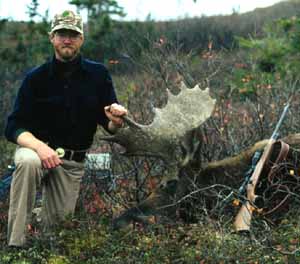
The Anchorage ADF&G Wildlife Office has an automated telephone that provides information about a variety of wildlife and hunting related topics. The main access number for this system is (907) 267-2347. You can break out of the automated system to speak to a real person during normal state office hours if you don’t find what you need. Alternatively, post a question in our "Ask a Trooper" forum. Common questions are fielded regularly by representatives of the Alaska State Troopers.
The Alaska Hunting Bulletin was published by the Division of Wildlife Conservation for several years in the late 1990's as a tabloid newsletter for hunters. The publication now exists online and can be seen AT THIS LINK.
The Alaska Department of Fish and Game provides caribou hunting information on a seasonal basis via recorded "hot lines." Click here to read more about some Alaska caribou hunting opportunities, and for the telephone numbers.
Fish and Game has also put together a number of small publications on various hunting topics. Here are a few that are available on the web:
An Introduction to Big Game Hunting in Alaska
An Introduction to Moose Hunting in Alaska
Care of Game Meat
Care of meat in the field is an important issue for hunters. Doug Drum of Indian Valley Meats (Anchorage area), an experienced hunter and long-time meat processor has prepared an excellent summary of how to preserve the table quality of meat between the time the animal dies and its eventual processing.
Hunters with more meat than they can use can donate to two Alaska programs that provide game meat for needy families. Alaskan hunters fighting hunger in Anchorage and Hunters for the Hungry in Fairbanks provide opportunities to share meat within the community.
Dall sheep hunters won't want to miss Chris Conway's "Alaska Sheep Hunting". Chris is an experienced Alaska sheep hunter and wildlife conservationist. We have also included the first chapter of Tony Russ' excellent Sheep Hunting in Alaska. Tony is a passionate sheep hunter and a fine writer. You can buy the book at less than retail on-line on this website. Tony has also written Sheep Stalking, which takes hunters through numerous stalking situations on Dall sheep, in order to boost your odds of success. Tony has several other books available, including Manual for Successful Hunters, which applies in areas outside Alaska as well.
Being in the field with bears makes Alaska hunting and fishing much more....well.... interesting. The Department of Fish and Game's "Bear Facts" tells how to improve the odds for keeping the peace. A book that you may find helpful is Steve Herrero's Bear Attacks: Their Causes and Avoidance. Herrero is a biologist and one of the continent's best experts on this subject.
An Alaska Hunting Bibliography was originally compiled by the Alaska Department of Fish & Game. We try to keep this up to date so you will have a good listing of what is available on the subject, as well as older books.
Check out the old forum archives for older posts on hunting around the state of Alaska.
Finally, as you plan your travel to Alaska, one of the handiest books out there is The Milepost. I have bought numerous editions of this book during the 30+ years we have lived in Alaska because it has in one spot all the travel information we need. The Milepost started out as a guidepost to the Alaska Highway, but it has grown to encompass nearly everything you need to know about traveling in the North country. Click here to order a copy.
Recent Alaska Hunting News
Improve your Alaska hunting prospects with books and videotapes from our store. Best sellers include: Alaska and Me, Sheep Hunting in Alaska, Hunting Hard in Alaska, This is My Alaska, and Bear Hunting in Alaska. General information on what it is like to hunt in various regions of the state.
What's Next in Alaska Hunting?
Alaska Hunt Planning: resources you need to put your own do-it-yourself Alaska hunting adventure.
Species pages: Want to learn more about Alaska's big-game species? We have detailed write-ups on each one.

